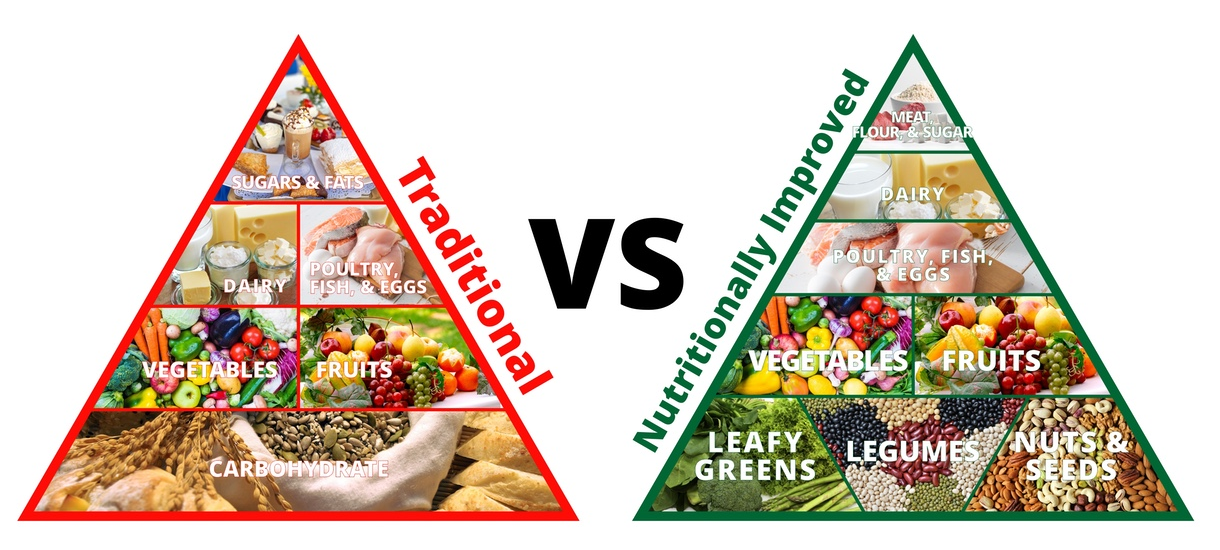The Food Pyramid was introduced to Americans in 1992, and many still look to it for guidance today. However, is the Food Pyramid still relevant? Let’s dive into this popular question!
What is the Food Pyramid?
In a nutshell, the Food Pyramid is a visual representation (structured in a pyramid form) that illustrates how different foods and drinks contribute to a balanced diet, and impact one’s overall lifestyle. Many remember this diagram being shown to them in school, usually in P.E or health class. Since 1992, the Food Pyramid has been a cornerstone reference for a well-balanced diet, one that many have been encouraged to tailor to their own lives.
Why Did the Food Pyramid Come Into Question?
While there are many stances on the Food Pyramid’s validity, a staple argument (which we’ll examine in this article) is the pyramid’s recommended serving size for grains and carbohydrates. While both are essential for a healthy lifestyle, critics began finding clear correlations between obesity and the recommended serving of carbohydrates roughly 15-20 years after 1992. While the USDA ultimately replaced the Food Pyramid with a more proportionally accurate model in 2011, the shape remained the same. With this said, can we still rely on its relevance at all?
Breaking Down the Old Model
As stated above, the previous Food Pyramid model places a heavy importance on refined grains including pastas, potatoes, breadsticks, and cereals, stating that Americans should consume 4 servings per day. The problem with this is that the Food Pyramid does not encourage wholesome grains that are full of nutrients and fiber. Instead, it leads Americans to believe that starchy, calorie dense (as opposed to nutrient dense) grains should be consumed more than any other food group.

Image retrieved from: hotandsourblog.com
Moving up…
In the old model, fruits and vegetables are actually positioned ideally. However, these definitely shouldn’t be consumed less than dairy products. 3-4 servings a day, or one serving at every meal, is encouraged for a more balanced diet.
Next, a heavy emphasis is placed on milk, cheese, and other dairy products, which in the early 90s was thought to be important for calcium absorption. However, dairy products are not the only source of calcium , nor are they the most beneficial. Seeds such as chia, sesame, and poppy actually contain more calcium than cheese and are more nutrient dense. Additional sources of calcium include plant-based foods such as beans and legumes, edamame and tofu, and leafy greens.
Next, the “meat, fish, and alternatives” section is not unideal, as we do need healthy protein sources to thrive. studies show that the average adult woman only requires 46 grams of protein per day, while the average adult male only requires 56. Therefore, the heavy emphasis on protein that many Americans place on their diet today is put into a healthy perspective in the old model.
Lastly, the old Food Pyramid recommends consuming fats, oils, and confectionery sparingly. This is perhaps one of the more flawed parts of the pyramid given what we know today. Healthy fats are both nutrient dense and satiating, meaning that consumers stay full longer, and therefore, eat less. Healthy fats such as avocados should earn a larger spot on the old Food Pyramid model.
What’s Our Conclusion?
While the old Food Pyramid model had good intentions for consumers, it missed the mark in many respects. In addition to the above, the old model’s structure places heavy emphasis on foods that contain a high percentage of a certain nutrient, such as dairy with respect to calcium. For example, a more sound approach would have been to call the section “calcium rich foods” as opposed to just “dairy”. The Food Pyramid (along with MyPlate and other government healthy eating guides) were never intended to be the “end-all-be-all” to a healthy lifestyle. Therefore, while the old model is not necessarily recommended, not all aspects of it should be considered unideal.
![NL Wordmark [Gradient] NL Wordmark [Gradient]](https://www.nextlevelurgentcare.com/wp-content/uploads/elementor/thumbs/NL-Wordmark-Gradient-7fm1iv6f0zylwqrxpy8kifrnrzsluqzzzofvqvs6smo.png)
